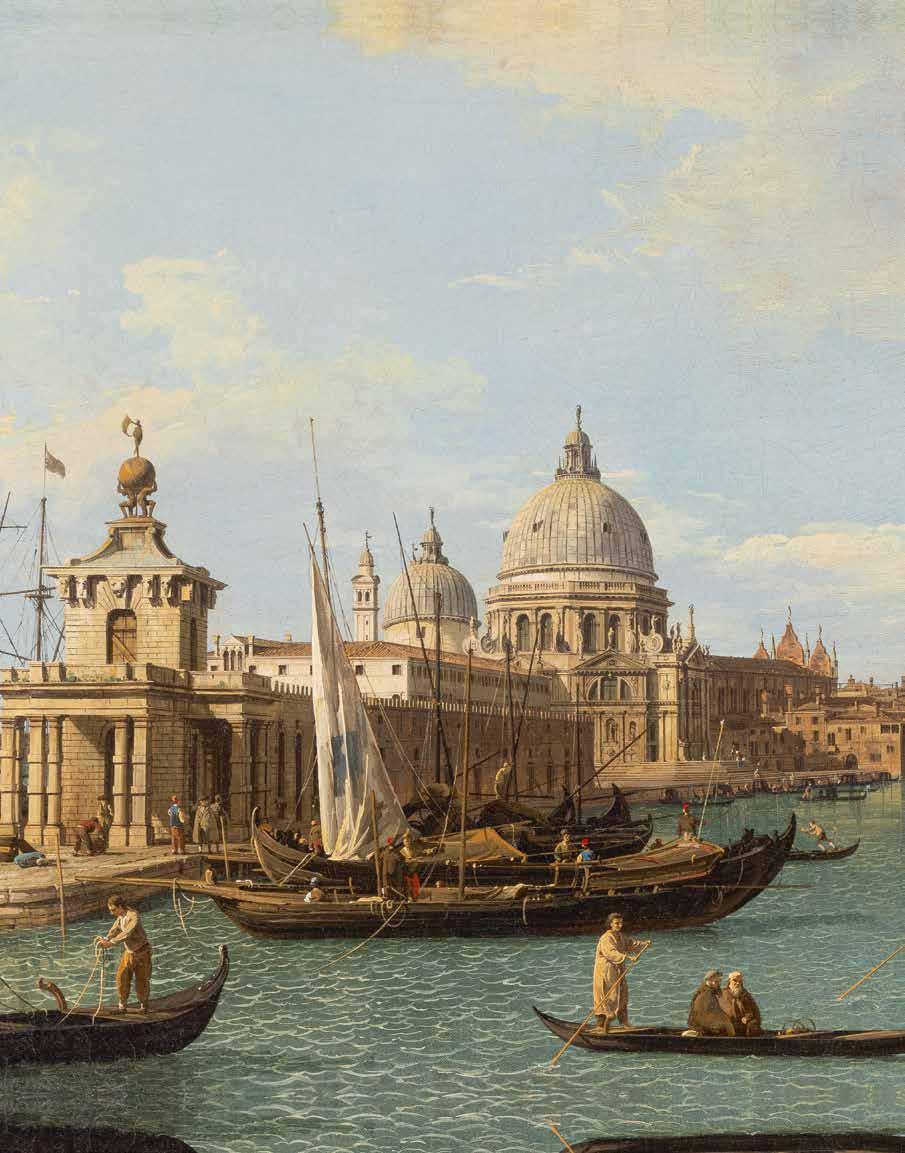

The Grand Tour destination italy

The Grand Tour destination italy
ARIANE VAN SUCHTELEN
JANNEKE BUDDING
JON CULVERHOUSE
MATTHEW HIRST
LAURA NUVOLONI
MARIA DE PEVERELLI
VICTORIA POULTON
LUCY PURVIS
MAURITSHUIS THE HAGUE ◆ WAANDERS PUBLISHERS ZWOLLE
Powered by
Top partners
Exhibition partners
Friends of the Mauritshuis
The Johan Maurits Compagnie Foundation
M.A.O.C. Gravin van Bylandt Fund
Gilles Hondius Foundation
The exhibition has been supported by the Dutch government: an indemnity grant has been provided by the Cultural Heritage Agency of the Netherlands on behalf of the Minister of Education, Culture and Science.
Preface
MARTINE GOSSELINK
Introduction
ARIANE VAN SUCHTELEN
The Grand Tour — Travel and Culture in the Eighteenth Century
JANNEKE BUDDING
Holkham Hall and the Grand Tour
MARIA DE PEVERELLI
Building the Library as a ‘Perfect Virtuoso’
LAURA NUVOLONI
Following in the Footsteps of Thomas Coke’s Grand Tour
LUCY PURVIS
Burghley House — The Travelling Earls
JON CULVERHOUSE
John Russell, 4th Duke of Bedford, Francis Russell, Marquess of Tavistock, and the Grand Tour — Woburn Abbey and its Collection
MATTHEW HIRST
Collecting Italian Vedute: The Canaletto Series at Woburn Abbey
PREFACE
Young adults call it a gap year: the year between leaving school and continuing their education. If you’re already working and feel the need for a change of scene, you take a sabbatical. Such a ‘time out’ seems to be typical of our times, but in fact it’s an age-old phenomenon. The English upper classes, especially the young men, routinely left home for such reasons, only they called it a Grand Tour. As early as the seventeenth century, these young aristocrats crossed the English Channel and went on to explore Europe. We know quite a bit about what they did on these journeys thanks to the journals and letters that survive. But we know far less about the actual organisation of such a Grand Tour, how many servants went along, how many horses and carriages were necessary, where Grand Tourists slept and ate and how they planned their next destination. The reason – or pretext – for undertaking this long and costly journey is clear, however: to gain a better understanding of classical antiquity, and to acquire knowledge of other cultures and learn other languages.
Travelling also had another objective: to sow one’s wild oats and then move beyond such youthful excesses to a more mature phase of young adulthood. The diaries kept on Grand Tours therefore recount as much about love affairs as about Roman antiquities. James Boswell, a Scottish lawyer and writer who embarked on a Grand Tour in 1764, was perfectly capable of combining the literature of antiquity and amorous adventures. Upon his arrival in Rome, he wrote: ‘I remembered the rakish deeds of Horace and those other amorous Roman poets, and I thought that one might well allow one’s self a little indulgence in a city where there are prostitutes licensed by the Cardinal Vicar.’
The fact that not all Grand Tourists took the educational aspect of their travels seriously is also confirmed by the French lawyer Charles de Brosses, a resident of Rome, who observed: ‘There are some who will have left the city at the time without having seen anyone but other Englishmen and without even knowing where the Colosseum is.’ The poet Samuel Rogers, who was in Italy in the 1820s, noted similar behaviour. He found it intolerable: ‘Nothing can be more depressing to those who really value Rome than to meet Englishmen hunting in couples through the Vatican galleries, one looking for the number of the statue in the guide-book, the other not finding it; than to hear Americans describe the Forum as the dustiest heap of old ruins ever looked upon… or, of the Colosseum, that ‘‘it will be a handsome building when it
is finished”.’ The intellectual Rogers was probably thinking ‘Do not cast your pearls before swine’ as he complained about the ignorance of his fellow tourists.
Nothing is more enjoyable for us than to read about the appreciation, or lack thereof, of cities and monuments that are now hotspots of mass tourism. Lady Mary Wortley Montagu wrote to her daughter in 1758: ‘Of all towns in Italy, I am the least satisfied with Venice… Old and in general ill-built houses, ruined pictures and stinking ditches dignified with pompous denomination of canals; a fine bridge spoilt by two rows of houses upon it, and a large square decorated with the worst architecture I yet saw.’
The diaries of English travellers are full of their dissatisfaction with Rome and its inhabitants. Writing in 1820, Lady Morgan complained: ‘You pass over miles of barren common, much like Hounslow Heath; and when at last you arrive at the gate of the Eternal City, the first impression is, I think, a feeling of disappointment… the habits of the people are in some measure restrained by the presence of the English. Still there is quite enough left to make me believe the Romans the nastiest people in Christendom – if I had not seen the Portuguese.’ Rome and Venice were not the only cities that provoked displeasure; other European cities also fell short of expectations. Paris, for example, was described in travel journals as a dirty, stinking city.
Despite all this criticism, we have countless testimonials that praise the grandeur and riches of these Continental cities. After the French writer Stendhal visited Florence in 1817 and described his ecstasy at seeing the graves of Machiavelli, Michelangelo and Galileo Galilei in the stunning basilica of Santa Croce, many travellers longed for the same experience. More and more people undertook Grand Tours. There was also an increase in the number of female travellers, whether or not accompanied by their husbands. Today, too, tourists are moved, dazed, overcome by the antiquity and sheer beauty of such cities as Florence and Venice. And, like tourists nowadays, the Grand Tourists of the past wanted to take home something that reminded them of their journey. This gave rise to the souvenir (literally ‘memory’), which became the third goal of the Grand Tour. In addition to gaining knowledge and maturity, Grand Tourists were bent on acquiring paintings, sculpture and antiquities. The carriages returning from Grand Tours were laden with souvenirs destined to decorate English country houses.
No place else in Europe can boast as many country estates with magnificent art collections as Great Britain, with its long tradition of wealthy, aristocratic families who commissioned the construction of splendid country houses surrounded by parks and gardens. Moreover, generations of travellers filled these stately homes with art collected largely on trips to the Continent. And because for centuries no war has been waged in England, these magnificent estates have often survived intact. The majority of England’s country houses now belong to such organisations as the National Trust, but ten of the most beautiful properties are still in private hands and still inhabited by descendants of the original owners. These ten, collectively called Treasure Houses of England, welcome visitors for a large part of the year. The exhibition The Grand Tour – Destination Italy displays pieces on loan from three of these renowned Treasure Houses: Holkham Hall in Norfolk, Burghley House in Lincolnshire and Woburn Abbey in Bedfordshire.
The Mauritshuis is honoured to work, once again, with these exceptional English organisations. Previous collaborations resulted in the exhibitions At Home in Holland: Vermeer and his Contemporaries from the British Royal Collection (20162017) and National Trust: Dutch Masters from British Country Houses (2018-2019). This time we are presenting, instead of Dutch masters, foreign painters whose work is not commonly found in Dutch museums, including Pompeo Batoni, Canaletto, Joshua Reynolds, Angelica Kauffman, Carlo Dolci and Paolo Veronese, as well as works by artists who are no longer well known but were very successful in their day, such as Luigi Garzi, Pietro Fabris and Nathaniel Dance.
We are greatly indebted to our lenders, Lord and Lady Leicester of Holkham Hall, Miranda and Orlando Rock of Burghley House, and the Duke and Duchess of Bedford of Woburn Abbey, all of whom were willing to give us their costly artworks on temporary loan. Without their extraordinary generosity, this exhibition would not have been possible.
Our curator Ariane van Suchtelen was the initiator of this exhibition, on which she worked closely with Maria de Peverelli, Head of Collections at Holkham Hall. Together they selected the loans on display in the exhibition. The project group, under the supervision of Lieve Boiten, worked very hard to make The Grand Tour – Destination Italy a success. Thank you, Lieve – your first exhibition as project leader, well done! The design of the exhibition was in the capable hands of Caspar Conijn. Gert Jan Slagter designed the book, which was printed
by Waanders Publishers. Dorine Duyster edited the texts and translated the English contributions into Dutch. Diane Webb translated the Dutch texts into English. The former curator-intraining at the Mauritshuis, Daphne Martens, and the present curator-in-training, Robin de Vries, assisted Ariane van Suchtelen, the editor of the catalogue.
This exhibition would not have been possible without the generous support of the NN Group, our Friends of the Mauritshuis Foundation, the VriendenLoterij, the Johan Maurits Compagnie Foundation, the M.A.O.C. Gravin van Bylandt Foundation and the Gilles Hondius Foundation. This exhibition is supported by an indemnity granted by the Cultural Heritage Agency of the Netherlands (RCE) on behalf of the Ministry of Education, Culture and Science (OCW).
Many thanks are due to Maria de Peverelli, Lucy Purvis, Katie Bolton and Laura Nuvoloni of Holkham Hall, Jon Culverhouse of Burghley House, and Matthew Hirst and Victoria Poulton of Woburn Abbey. We would also like to thank the following individuals: Tom Aalmoes, Janneke Budding, Arco Gnocchi, Nynke de Jong, Andrea Huntjens, Janneke Knüpfer and Vava Stojadinovic, Maria Smit, Marita Smit, Maud van Suylen, Joost van der Spek, Guy Sainthill and Roderik van der Weijden.
Martine Gosselink, General Director Mauritshuis
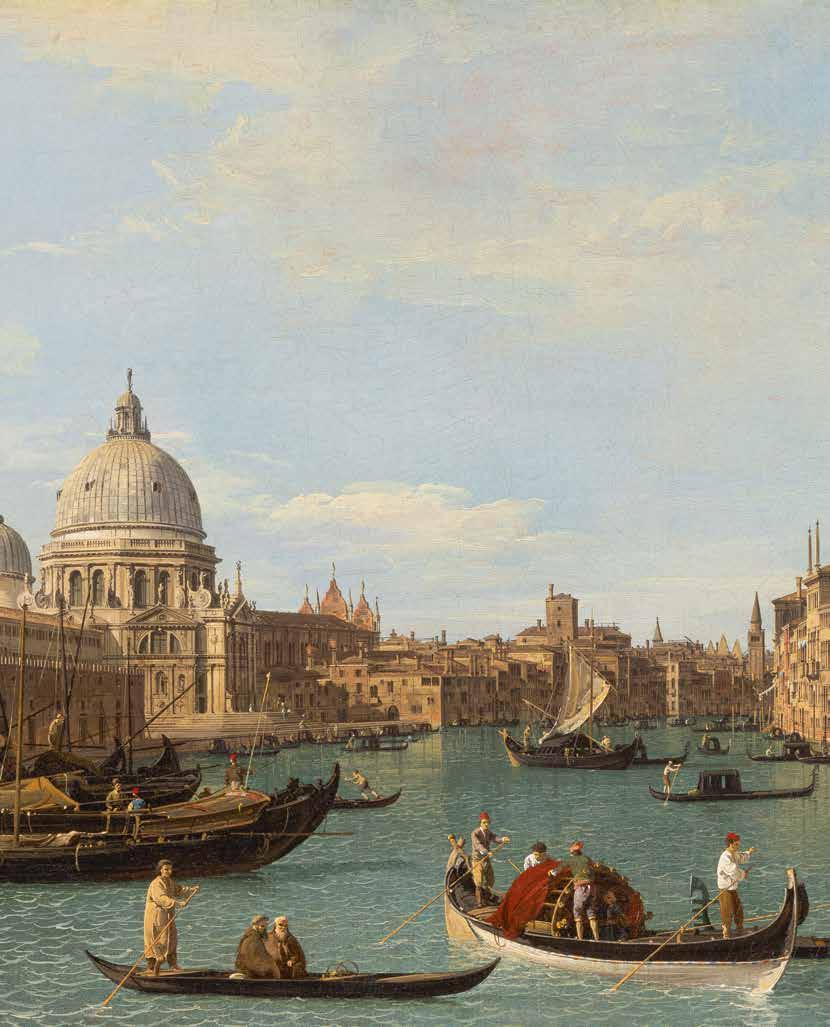
THE GRAND TOUR – DESTINATION ITALY INTRODUCTION
Ariane van Suchtelen
School-leavers nowadays often take a gap year to go abroad and see other parts of the world, hoping to have a few adventures and to meet new people. Whether reluctantly or willingly, their parents let them go: after all, sooner or later their offspring have to grow up. Throughout history, young and old alike have had the desire to explore foreign countries, but in centuries past, this was beyond the means of most people. In the heyday of the Grand Tour, foreign travel was a costly, time-consuming and not infrequently risky undertaking (see pp. 17-21).
By the eighteenth century, the Grand Tour had become a familiar phenomenon, but even before this, young men had been sent abroad with private tutors and other attendants as a means of completing their education. The term Grand Tour was coined by Richard Lassels (1603-1668), an English travel-book writer and Catholic priest who travelled to Italy five times as a tutor. In 1670, Lassels’ travel guide The Voyage of Italy or a Compleat Journey through Italy was published posthumously, in which he observed: ‘No man understands Livy and Caesar...’ (in other words, classical antiquity) ‘like him, who hath made exactly the Grand Tour of France and the Giro of Italy’.
Rite of Passage
From the seventeenth to the mid-nineteenth century – when the construction of the railways changed European travel for good – the Grand Tour was a rite of passage for young men of the upper crust, especially the British, who travelled to the Continent with Italy as their ultimate destination. There they visited the famous monuments of Roman antiquity and became acquainted with the art and culture of the Renaissance. Grand Tourists visited not only Rome and Florence, but also Venice, for example, which was then just as popular among tourists as it is today. A natural phenomenon such as Vesuvius, the active volcano near Naples, was also a special attraction. The Grand Tour was considered an essential part of the cultural and social education of the elite, a period preceding adulthood that was meant for making useful contacts and acquiring good taste. It was nothing less than an intensive preparation course for a role in society. But the Grand Tour can also be defined more broadly. It was not only young unmarried men who undertook such travels. Somewhat older gentlemen also toured Europe, and in the course of the eighteenth century, more and more women followed suit, usually in the company of their husbands. Sometimes whole families went abroad, travelling with children, servants and horses parading in their wake. John Cecil, 5th Earl of Exeter, and his wife, Anne Cavendish, were pioneers in this respect. As early as the seventeenth century, they journeyed repeatedly through Europe, where they purchased a great many paintings and other objects intended for the decoration of Burghley House, their country estate. Who were the Cecils, and who were the other people who journeyed so far from home at a time when travel was not yet taken for granted? What did they look at, and what did they take home in the way of art and other souvenirs?
This exhibition focuses on a few exceptional travellers whose passion for collecting art, both old and new, provided the basis for the splendid collections at Holkham Hall, Burghley House and Woburn Abbey.
Notebooks and Other Documents
The archives of these three Treasure Houses of England, which are still inhabited by descendants of the original owners, contain a wealth of information on the foreign adventures experienced by these Grand Tourists of the past. Their holdings range from notebooks and account books, letters and inventory lists, to handwritten inscriptions on the backs of paintings and even a single piece of paper in a hardstone snuff box (fig. 1). On this paper Brownlow Cecil, 9th Earl of Exeter, noted that the three small rocks preserved in the box had been taken by English sailors from Pompey’s Pillar in Alexandria, after drinking a bowl of punch at the top of this monument erected in honour of the Emperor Diocletian. The same note states that the precious box is made of lava from the island of Ischia near Naples.
The archives of Woburn Abbey contain a well-thumbed notebook that must have belonged to John Russell, 4th Duke of Bedford, the man who ordered an unprecedentedly large series of Venetian vedute from Canaletto (see cat. nos. 30-31). The notebook contains fragmentary notes made by Russell on his Grand Tour of 17281732. Perhaps this is the very book that Russell holds in his hand in the small portrait on ivory that he commissioned in Rome (fig. 2).
Steward Culpepper Tanner accompanied John Cecil, 5th Earl of Exeter, on various trips to the Continent. Tanner recorded every payment he made for Cecil and his entourage, including small amounts for the cold drinks sold at roadside stands near tourist attractions. Sometimes one of Tanner’s notes can be linked to a particular souvenir, as is the case with the essence bottle ‘carved in the form of a pine cone’, which is so beautiful that it has been preserved to the present day at Burghley House (fig. 3). From Livorno, Tanner had crates of paintings shipped to England.
The most detailed records are to be found in the account book kept by the valet de chambre Edward Jarrett, who accompanied the young Thomas Coke on his Grand Tour of 1712-1718. Jarrett’s bookkeeping is so meticulous that it makes readers feel like fellow travellers. We know, for example, that Coke and his company drank cocoa nearly every day, for Jarrett, too, recorded the smallest expenses. Even more importantly, Jarrett’s account book provides insight into Thomas’s determination to amass a collection of art, antiquities and valuable books with a view to installing these treasures in the stately home he intended to build after his return to England. His vision gave rise to the magnificence of Holkham Hall (pp. 24-31, 54-57).
Posing Along The Way – Portraits as Souvenirs
In the eighteenth century it became customary for Grand Tourists to have themselves portrayed abroad, as a souvenir of their Italian sojourn. In Rome one could go to the famous portraitist Pompeo Batoni (1708-1787), whose clientele were almost exclusively English. Batoni’s portrait of Thomas William Coke of 1774 is an imposing example of just such a ‘Grand Tour portrait’ (fig. 4). Nineteen-year-old Thomas William Coke is portrayed full length, elegantly dressed in a red cloak trimmed with ermine, with a noble hunting hound at his feet. Behind him at right stands a Roman statue of Ariadne from the Vatican Collection that Batoni depicted in various portraits. The sitter could make an impression at home with such a monumental likeness. Another portraitist who was very popular with the English was Rosalba Carriera (1675-1757) in Venice. She painted portrait miniatures on ivory, but her fame was due mainly to her innovative pastel portraits on paper, which became her trademark. Carriera’s small formats made it possible for travellers to pack up a portrait on ivory or paper and take it home in their luggage. In 1714, Thomas Coke commissioned Carriera to paint his portrait on ivory
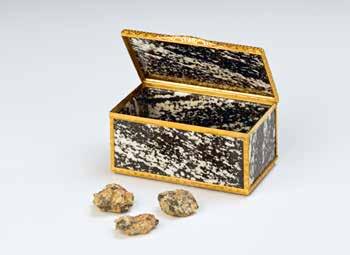
Fig. 1
Anonymous (Italy), Snuff box with rocks, before 1767. Hardstone (black and white polished lava), gold, width 7.5 cm. Burghley House (cat. no. 24)
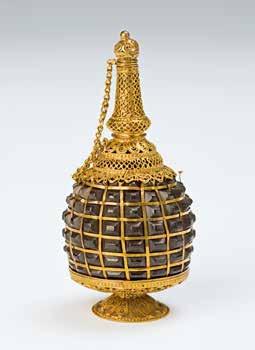
3
Anonymous Indo-Portuguese artist, Essence Bottle Carved in the Form of a Pine Cone, 17th century. Organic material, garnished with gold wire, height 7.8 cm, Burghley House (cat. no. 25)

Fig. 2
Detail of Orsola Urbani (attributed to), Portrait of a Man Traditionally Identified as Lord John Russell, later 4th Duke of Bedford (1710-1771), c.1730. Watercolour on ivory, 15.4 x 12 cm, Woburn Abbey (cat. no. 26)
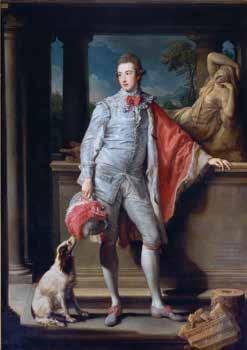
Fig. 4
Pompeo Batoni, Portrait of Thomas William Coke (1754-1842) 1774. Canvas, 248.8 x 170.3 cm. Holkham Hall (cat. no. 3)
Fig.
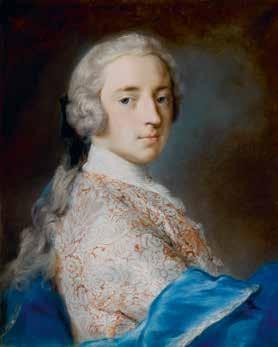
5
Rosalba Carriera, Portrait of Viscount Edward Coke (1719-1753), c.1739. Pastel on paper, 50.8 x 43.2 cm. Holkham Hall (cat. no. 2)

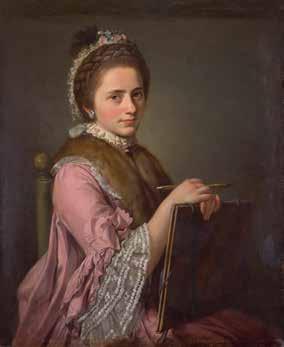
Nathaniel Dance, Portrait of Angelica Kauffman (1741-1807), 1764. Canvas, 83 x 69 cm. Burghley House (cat. no. 11)

Jean Petitot the Younger after Peter Lely, Portrait of Anne Cavendish (1649-1703), c.1677. Miniature, height 38 cm.
Fig. 8
Burghley House
Fig.
Fig. 6
Fig. 7
Joshua Reynolds, Portrait of Francis Russell, Marquess of Tavistock (1739-1767), 1765-1766. Canvas, 123 x 98 cm. Woburn Abbey (cat. no. 27)
(see cat. no. 1). Some twenty-five years later it was his son Edward’s turn to pose for the artist in Venice. Edward chose the pastel technique, which had meanwhile become very fashionable (fig. 5). This engaging portrait of Edward Coke, who met an untimely death in his mid-thirties, is a highlight of Carriera’s refined portraiture and immediately makes clear why her colourful pastels were so much in demand.
In Italy there were also a number of foreign artists who were eager to paint travellers’ portraits. The most famous was undoubtedly the Swiss-Austrian Angelica Kauffman (1741-1807). A superstar in her own lifetime, she had flocks of admirers who were just as interested in their idol’s love life as they were in her art. In 1764 in Naples, Kauffman painted the portrait of Brownlow Cecil, 9th Earl of Exeter, who travelled to Italy for the first time as a 38-year-old widower (see cat. no. 10). In the background of Cecil’s portrait, Kauffman depicted the Bay of Naples with the smoking Vesuvius, the volcano that never failed to put on a spectacular, fiery display (see cat. no. 12). Shortly after Kauffman painted his likeness, Cecil bought a portrait of the artist herself, painted in Rome by the Englishman Nathaniel Dance (fig. 6). Cecil was so impressed by Kauffman that he eventually became one of the most important collectors of her work.
The Portrait of Francis Russell, Marquess of Tavistock by the English portraitist Joshua Reynolds (1723-1792) looks like a typical Grand Tour portrait, but in reality it was painted a few years after the sitter’s return to England (fig. 7). Tavistock had a small bronze after Michelangelo, which he had purchased in Italy, depicted on the table next to him as a reference to his travels (see cat. no. 28). Bronze copies of antique and Renaissance statues were extremely popular as classy souvenirs. This portrait provided proof of the good taste Tavistock had acquired on his Grand Tour.
Several Protagonists and their Grand Tour Purchases
The narratives reconstructed in this exhibition are based on the histories of the most important Grand Tourists of Burghley House, Holkham Hall and Woburn Abbey: John Cecil, 5th Earl of Exeter, and his wife, Anne Cavendish, who purchased hundreds of contemporary Italian paintings for Burghley House, the country estate they renovated; Thomas Coke, who had Holkham Hall built after his Grand Tour; John Russell, 4th Duke of Bedford, to whom Woburn Abbey is indebted for the series of Venetian views by Canaletto; and Brownlow Cecil, 9th Earl of Exeter, who, following in the footsteps of his great-grandparents, journeyed twice to Italy, where he purchased art that further enriched the collection of Burghley House, his family home.
John Cecil (1648-1700) owed his great fortune to his marriage to Anne Cavendish (16491703), daughter of the immensely wealthy Earl of Devonshire (fig. 8). The couple first travelled to the Continent in 1679-1681, and before 1700, Lord Exeter undertook three more European tours, sometimes in the company of his wife.
Purchases were made on a grand scale in France and Italy for the embellishment and enrichment of Burghley House, which, thanks to Anne’s money, was transformed from a somewhat outmoded sixteenth-century Tudor house into a magnificent and richly decorated palace (see pp. 60-69). A fortune was spent during those Continental travels on furnishings for Burghley House – pieces of furniture, tapestries, textiles, and no fewer than three hundred paintings by contemporary Italian masters, many of which are still preserved there. Never before had so much art been purchased for an English country house.


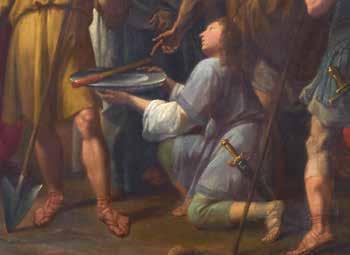
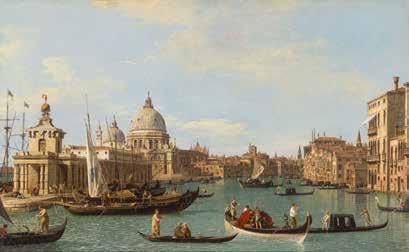
Fig. 9
Caspar Adriaansz van Wittel, known as Vanvitelli, View of Saint Peter’s Square, Rome, 1716. Canvas, 54.6 x 114.3 cm. Holkham Hall (cat. no. 5)
Fig. 10
Claude Gellée, named Lorrain, View of a Seaport and Amphitheatre, 1652(?). Canvas, 73.6 x 91.1 cm. Holkham Hall (cat. no. 4)
Fig. 11
Detail of Luigi Garzi, Cincinnatus at the Plough, 1716. Canvas, 182.8 x 21.9 cm. Holkham Hall (cat. no. 6)
Fig. 12
Giovanni Antonio Canal, named Canaletto, The Grand Canal in Venice, Looking West, c.1732-1736. Canvas, 47 x 79 cm. Woburn Abbey (cat. no. 30)
Thomas Coke, Earl of Leicester (1697-1759) was the very model of the classic Grand Tourist: a young man sent abroad to complete his education. He was still just fifteen when he set out in 1712 in the company of various attendants, among them his tutor, Dr Thomas Hobart, Fellow of Christ’s College, Cambridge, and the previously mentioned Edward Jarrett. Thomas stayed away from home all of six years, much longer than the average Grand Tourist.
One of the people he met during his travels was the architect William Kent (16851748), who would later play a crucial role in the design and construction of Holkham Hall. Despite his tender age, Thomas Coke had a mission: the formation of an art collection to decorate his future family home. He bought paintings, drawings, statues, books and illuminated manuscripts for his library, and much, much more. From Caspar van Wittel (1653-1736) of Amersfoort, who had settled in Italy, he acquired views of the cities he had visited, a highlight being the resplendent view of St Peter’s in Rome (fig. 9). It was Van Wittel who had introduced the cityscape, a genre that had emerged a century before in Dutch art, to Italy (where he was known as Vanvitelli). Thomas Coke was the most avid English collector of this Dutchman’s work. Coke also collected the work of the French landscape painter Claude Lorrain (1600-1682), who was extremely popular in England and whose Arcadian depictions of the Italian countryside were in great demand. View of a Seaport and Amphitheatre portrays an artist sketching a Roman temple (fig. 10). Coke’s wide-ranging interests included a partiality for contemporary Italian history painting. From Luigi Garzi (1638-1721) – then one of the most sought-after painters in Rome – he commissioned Cincinnatus at the Plough, in which he had himself portrayed kneeling at the feet of this Roman military leader (fig. 11).
John Russell (1710-1771) undertook a Grand Tour in the years before he became the 4th Duke of Bedford in 1732. In the spring of 1731 he was in Venice, the city whose enchanting beauty appealed to the imagination of many foreign visitors. For these travellers, the souvenir of choice was a painted cityscape, a postcard avant la lettre. Canaletto (1697-1768) succeeded as none other in meeting the demand for such mementos with his lively vedute. Through the British consul, Joseph Smith, whose palazzo on the Canal Grande served as a showroom for Canaletto’s art, Russell placed his first orders. This led to the unparalleled series of twenty-four views of Venice by this peerless Venetian painter (fig. 12). These Canalettos were initially kept at Bedford House in London, but since around 1800 the ensemble has decorated the dining room of Woburn Abbey.
Brownlow Cecil, 9th Earl of Exeter (1725-1793), was the great-grandson of John Cecil, the 5th Earl. He was nearly forty when he first travelled to the Continent, and his interests were broader than those of his seventeenth-century predecessors. During his two trips to Italy, he not only bought the work of living artists, but also went in search of paintings by masters of the past. In Rome he managed to acquire a painting then ascribed to Leonardo da Vinci. This attribution proved too optimistic: the painting in question, Madonna with the Cherries, has since been recognized as a work by the sixteenth-century Flemish painter Joos van Cleve (c. 1485-1540) (fig. 13). On his second trip to Italy, the 9th Earl purchased a couple of costly paintings by Paolo Veronese (1628-1588), which had come from a church on the island of Murano in the lagoon of Venice. Typical of Grand Tour souvenirs are the micro-mosaics made by Cesare Aguatti (see cat. no. 17), which Cecil ordered in Rome through Thomas Jenkins, a British art and antique dealer who had a rather shady reputation. Another object he acquired

13
14
Anonymous, A Crouching
18th

from Jenkins is the small marble statue of a crouching lion (fig. 14). An inventory of the contents of Burghley House states that the statue was found in 1725 in the ancient Roman port of Ostia. Jenkins had presumably let the buyer believe that it was an antique Roman sculpture. But the fact that this lion does not stem from antiquity is compensated for by its charm as a work of art.
Fascinating stories can be told about art collecting, stories in which colourful personages play the leading role. Thanks to the three Treasure Houses participating in this exhibition – Holkham Hall, Burghley House and Woburn Abbey – a wealth of information has come to light about the Grand Tourists whose pursuit of art, in Italy in particular, led to the formation of such marvellous collections.
Fig.
Joos van Cleve, Madonna with the Cherries. Panel, 76 x 55.5 cm. Burghley House
Fig.
Lion, probably
century. Pink marble, 16.5 x 23 cm. Burghley House (cat. no. 22)
THE GRAND TOUR
TRAVEL AND CULTURE IN THE EIGHTEENTH CENTURY
Janneke Budding
A trip abroad is nothing out of the ordinary nowadays,1 but this was not the case in the eighteenth century. In those days, foreign travel was a privilege enjoyed by the elite, and it cost not only much effort and money, but also a great deal of time. A Grand Tour to France and Italy, an essential part of the education of young British men of a certain standing, took anywhere from six months to more than two years. The journey was not undertaken alone, but in the company of one or more servants. Add to that the cost of travel and lodgings, and it is clear that a Grand Tour was reserved for the nobility and the upper classes. To make sure that their dear son did not abandon himself to frivolous pursuits while travelling abroad, the parents usually hired a tutor. This person, often mockingly called a ‘bear leader’, was expected to keep his pupil on the straight and narrow path of art, science and culture (figs. 1 and 2).
The Grand Tour was not reserved exclusively for men. In the second half of the eighteenth century in particular, upper-class British women often journeyed to France and Italy in the company of their husbands. Examples include Mrs Hester Lynch Piozzi and Lady Anna Miller, both of whom published accounts of their travels.2
The classic Grand Tour required thorough preparation. The first arrangements to be made involved the route to be taken after crossing over to France and which means of transport to use. One’s own carriage was a possibility, but an alternative was to buy a coach and team of horses on the other side of the Channel and sell them before returning home. Travelling by diligence was the least expensive mode of transport, and therefore had the least standing.
The fashionable city of Paris was the first stopping point on the Grand Tour. Because most British travellers spent a relatively long time there, it was practical to hire a French valet de place for the duration of their stay, even for those who had brought along servants. Such a manservant was acquainted with the city and its ways, and also knew which tailors and other tradesmen to go to in order to acquire a new wardrobe and accessories. In the words of the Scottish writer Tobias Smollett: ‘When an Englishman comes to Paris, he cannot appear until he has undergone a total metamorphosis. At his first arrival he finds it necessary to send for the tailor, perruquier, hatter, shoemaker, and every other tradesman concerned in the equipment of the human body. He must then change his buckles, and the form of his ruffles.’3 Grand Tourists who dressed with extreme flamboyance were mockingly called ‘macaroni’ (fig. 3).
From Paris the journey continued to Lyon, where Grand Tourists had to decide how to travel to Italy. They could take the diligence to Marseille, where there was a boat to Genoa – a sea crossing that was not without danger, owing to pirates – or cross the Alps via the 2100-metre Mont Cenis pass. This route meant being carried in a so-called sedan chair, equipped with two long poles, front and back, for the porters. (fig. 4). When no longer necessary, this portable chair was dismantled and carried by mules like the rest of the baggage. Sedan chairs were reasonably comfortable: the passenger’s feet rested on a rope, the elbows on wooden armrests. The poles were provided with straps that went over the porters’ shoulders, to distribute the weight. Many a Grand Tourist praised the swiftness and sureness of foot with which the ‘chair men’, wearing spiked shoes, negotiated the steep mountain paths.

Fig. 1
Pier Leone Ghezzi, Dr James Hay as ‘bear leader’, c.1725. Pen and brown ink, 163 x 243 mm. British Museum, London

3
Philip Dawe, The Macaroni, 1773. Mezzotint, 351 x 250 mm. British Museum, London

Fig. 2
Katherine Read, British Gentlemen in Rome, c.1750. Canvas, 94.5 x 134.5 cm. Yale Center for British Art, Paul Mellon Collection, New Haven
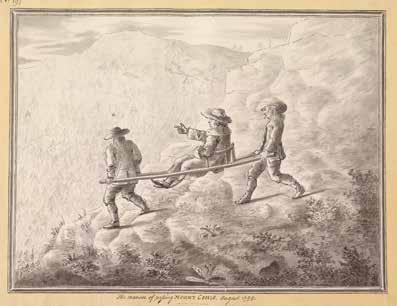
Fig. 4
George Keate, ‘A Manner of Passing Mount Cenis’, from an album of 232 drawings of a journey through France, Switzerland and Italy, 1754-1756. Pen and black ink, grey wash, 178 x 236 mm. British Museum, London
Fig.
Once they had arrived in Piemonte, Grand Tourists were delighted, even ecstatic, to find themselves in Italy, the cradle of the Renaissance. But their delight did not always extend to their accommodation en route. The inns and hotels in Italy’s famous centres of culture were generally good, but outside the large cities they had a very bad reputation. Dr Sharp, a renowned British surgeon who toured Italy in 1765 and 1766, fulminated: ‘At Turin, Milan, Venice, Rome, and, perhaps, two or three other towns, you meet with good accommodation but no words can express the wretchedness of the other inns. No other beds than one of straw, with a matrass [sic] of straw, and next to that a dirty sheet, sprinkled with water, and, consequently, damp.’4
Grand Tourists were attracted to Venice for a variety of reasons (see cat. nos. 30-31), not least its unique situation in a lagoon and its impressive art and architecture. Another enticement was its age-old reputation as the city of sin. In addition to the ridotti (gaming houses, at which it was obligatory to wear a mask), there were many prostitutes, who, according to the historian and author Thomas Nugent, were considered by some Grand Tourists to be the only reason to travel to Italy.5 Thomas Coryat, who travelled around Italy at the beginning of the seventeenth century,6 reported that Venice had all of 20,000 ‘courtisanes’ in a population numbering 200,000.
Although Venice itself had much to offer, this was far from true of Venetian cuisine. Lady Miller complained about the ‘wretched cooks’ and was disgusted by the local custom of using animal blood in soups and ragouts.7
Most Grand Tourists proceeded from Venice via Bologna to Florence and Rome. Because the road passed through mountainous terrain, on this leg of the journey carriages were drawn by six horses, two more than in ordinary circumstances. In the Eternal City, the prime destination was St Peter’s Basilica (see cat. no. 5). Lady Miller was impressed by the appearance St Peter’s, which in her opinion was ‘much more splendid’ in reality than in the famous etchings by Giovanni Battista Piranesi that she had studied in England (fig. 5). Yet in spite of this favourable impression, she noted many points of criticism. The colonnade, for example, displayed ‘a most striking fault in the architecture; the pillars, which are of stone, show heavy and crowded’. She also criticized the façade of St Peter’s: ‘There are so many ornaments, such twisting and turning.’8
Young milordi inglesi, for whom the traditional sights of the Grand Tour were of secondary importance, met in the coffee houses on the Piazza di Spagna, the ‘English ghetto’. Grand Tourists who had seen enough of Rome were also inclined to travel a further thirty kilometres to higher-lying Tivoli, to inspect in comparative coolness the summer palaces and ample gardens of the Italian nobility and also Tivoli’s villas and temples of antiquity.
It was customary for British Grand Tourists to have their portrait painted in Italy or at least to commission copies of famous paintings. During their travels, they acquired paintings and sculptures, both originals and copies, as well as cameos, fossils, archaeological finds, coins and maps. In 1764 the renowned British actor David Garrick wrote from Rome to a friend: ‘You must know that I am antiquity hunting from Morning to Night & my poor wife drags her lame leg after me.’9
A number of Grand Tourists travelled on from Rome to Naples. The food and accommodation on this stage of the trip were notorious. Lady Miller was appalled by the ‘rotten eggs, and some ragouts of liver and brains stewed in oil, out of the same reservoir with that used in the lamp.’10 Dr Samuel Sharp wrote: ‘[A]ll the way to Naples we never once crept between the sheets, not daring to encounter the vermin and nastiness of those beds.’11
After visiting Pompeii, climbing Vesuvius (see cat. no. 12), and experiencing the pleasures of Naples, it was time for the return journey. Back home, the milord’s portrait, with a view of Rome or Florence in the background, was hung in pride of place.
Grand Tourists and the Servants Who Accompanied Them
Grand Tourists who aspired to return to Great Britain as connoisseurs were advised to see the sights of Rome in the company of a hired antiquarian: an expert in art and archaeology. To such a serious programme one might have to devote three hours a day for a full six weeks.
A reliable antiquarian was not easy to find. Many people, undeterred by their lack of specialist knowledge, offered their services. The excessively frugal Tobias Smollett refused to hire an antiquarian and instead found a servant who knew his way around Rome. The English writer and politician William Beckford (1760-1844), who travelled to Italy in 1782 with a retinue of more than twenty servants – including a tailor, a cook, a barber, an artist entrusted with making sketches, and his personal physician – would not even contemplate exploring Rome under the guidance of an alleged expert.
‘I absolutely will have no antiquary to go prating from fragment to fragment, and tell me, that were I to stay five years at Rome, I should not see half it contained. The thought alone, of so much to look at, is quite distracting, and makes me resolve to view nothing at all in a scientific way; but straggle and wander about, just as the spirit chuses.’ 12
A Grand Tourist had to cope with many unforeseen circumstances. To ease the discomfort of travelling, however, there were always servants, whether brought from home or hired locally. It was the job of the tutor to find such temporary personnel. The ideal servant answered as much as possible to the following description:
‘A servant selected to accompany a gentleman on his travels should be conversant with the French language. Moreover, he should write a legible hand and bleed well in case his master should meet with an accident where no surgical aid is to be expected.’ 13
In addition, the ideal servant was dependable, well-trained and had a great sense of responsibility. But not all travelling servants were endowed with these qualities. The poet Lord Byron (1788-1824), who travelled around Italy in the company of an English servant from 1816 to 1819, complained:
‘The perpetual lamentations after beef and beer, the stupid, bigoted contempt for everything foreign, an insurmountable incapacity for acquiring even a few words in any language, rendered him like all other English servants, an incumbrance.’ 14
British personnel seem to have been remarkably eager to travel as servants abroad. The London newspaper The Morning Post published, in 1815 alone, around a thousand advertisements placed by ‘travelling servants’ seeking work, among them numerous women.
‘Wants a situation, a young person as lady’s-maid, or to attend upon an elderly lady. She fully understands her business, and has no objection to travel.’ 15
‘Respectable Young Woman, 23 years of age seeks a job as a lady’s maid and would prefer going abroad.’ 16
